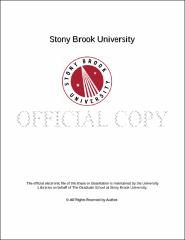| dc.identifier.uri | http://hdl.handle.net/11401/77788 | |
| dc.description.sponsorship | This work is sponsored by the Stony Brook University Graduate School in compliance with the requirements for completion of degree. | en_US |
| dc.format | Monograph | |
| dc.format.medium | Electronic Resource | en_US |
| dc.language.iso | en_US | |
| dc.publisher | The Graduate School, Stony Brook University: Stony Brook, NY. | |
| dc.type | Thesis | |
| dcterms.abstract | This study measured the material properties of zooplankton, Pacific hake (Merluccius productus), Humboldt squid (Dosidicus gigas), and two species of myctophids (Symbolophorus californiensis and Diaphus theta) collected from the California Current ecosystem. The density contrast (g) was measured for euphausiids, decapods (Sergestes similis), amphipods (Primno macropa, Phronima sp., and Hyperiid spp.), siphonophore bracts, chaetognaths, larval fish, crab megalopae, larval squid, and medusae. Morphometric data (length, width, and height) were collected for these taxa. Density contrasts varied within and between zooplankton taxa. The mean and standard deviation for euphausiid density contrast were 1.059 ± 0.009. Relationships between zooplankton density contrast and morphometric measurements, geographic location, and environmental conditions were investigated. Site had a significant effect on euphausiid density contrast. Density contrasts of euphausiids collected in the same geographic area approximately 4-10 days apart were significantly higher (p < 0.001). Sound speed contrast (h) was measured for euphausiids and pelagic decapods (S. similis) and it varied between taxa. The mean and standard deviation for euphausiid sound speed were 1.019 ± 0.009. Euphausiid mass was calculated from density measurements and volume, and a relationship between euphausiid mass and length was produced. We determined that euphausiid from volumes could be accurately estimated two dimensional measurements of animal body shape, and that biomass (or biovolume) could be accurately calculated from digital photographs of animals. Density contrast (g) was measured for zooplankton, pieces of hake flesh, myctophid flesh, and of the following Humboldt squid body parts: mantle, arms, tentacle, braincase, eyes, pen, and beak. The density contrasts varied within and between fish taxa, as well as among squid body parts. Effects of animal length and environmental conditions on nekton density contrast were investigated. The sound speed contrast (h) was measured for Pacific hake flesh, myctophid flesh, Humboldt squid mantle, and Humboldt squid braincase. Sound speed varied within and between nekton taxa. The material properties reported in this study can be used to improve target strength estimates from acoustic scattering models which would increase the accuracy of biomass estimates from acoustic surveys for these zooplankton and nekton. | |
| dcterms.abstract | This study measured the material properties of zooplankton, Pacific hake (Merluccius productus), Humboldt squid (Dosidicus gigas), and two species of myctophids (Symbolophorus californiensis and Diaphus theta) collected from the California Current ecosystem. The density contrast (g) was measured for euphausiids, decapods (Sergestes similis), amphipods (Primno macropa, Phronima sp., and Hyperiid spp.), siphonophore bracts, chaetognaths, larval fish, crab megalopae, larval squid, and medusae. Morphometric data (length, width, and height) were collected for these taxa. Density contrasts varied within and between zooplankton taxa. The mean and standard deviation for euphausiid density contrast were 1.059 ± 0.009. Relationships between zooplankton density contrast and morphometric measurements, geographic location, and environmental conditions were investigated. Site had a significant effect on euphausiid density contrast. Density contrasts of euphausiids collected in the same geographic area approximately 4-10 days apart were significantly higher (p < 0.001). Sound speed contrast (h) was measured for euphausiids and pelagic decapods (S. similis) and it varied between taxa. The mean and standard deviation for euphausiid sound speed were 1.019 ± 0.009. Euphausiid mass was calculated from density measurements and volume, and a relationship between euphausiid mass and length was produced. We determined that euphausiid from volumes could be accurately estimated two dimensional measurements of animal body shape, and that biomass (or biovolume) could be accurately calculated from digital photographs of animals. Density contrast (g) was measured for zooplankton, pieces of hake flesh, myctophid flesh, and of the following Humboldt squid body parts: mantle, arms, tentacle, braincase, eyes, pen, and beak. The density contrasts varied within and between fish taxa, as well as among squid body parts. Effects of animal length and environmental conditions on nekton density contrast were investigated. The sound speed contrast (h) was measured for Pacific hake flesh, myctophid flesh, Humboldt squid mantle, and Humboldt squid braincase. Sound speed varied within and between nekton taxa. The material properties reported in this study can be used to improve target strength estimates from acoustic scattering models which would increase the accuracy of biomass estimates from acoustic surveys for these zooplankton and nekton. | |
| dcterms.available | 2017-09-20T16:53:35Z | |
| dcterms.contributor | Lonsdale, Darcy | en_US |
| dcterms.contributor | Warren, Joseph D. | en_US |
| dcterms.contributor | Peterson, Brad. | en_US |
| dcterms.creator | Becker, Kaylyn Nichole | |
| dcterms.dateAccepted | 2017-09-20T16:53:35Z | |
| dcterms.dateSubmitted | 2017-09-20T16:53:35Z | |
| dcterms.description | Department of Marine and Atmospheric Science. | en_US |
| dcterms.extent | 57 pg. | en_US |
| dcterms.format | Application/PDF | en_US |
| dcterms.format | Monograph | |
| dcterms.identifier | http://hdl.handle.net/11401/77788 | |
| dcterms.issued | 2013-12-01 | |
| dcterms.language | en_US | |
| dcterms.provenance | Made available in DSpace on 2017-09-20T16:53:35Z (GMT). No. of bitstreams: 1
Becker_grad.sunysb_0771M_11615.pdf: 2193512 bytes, checksum: c61c2bb4f63c38943dfaac346064f8de (MD5)
Previous issue date: 1 | en |
| dcterms.publisher | The Graduate School, Stony Brook University: Stony Brook, NY. | |
| dcterms.subject | Acoustics | |
| dcterms.subject | acoustics, material properties, nekton, zooplankton | |
| dcterms.title | Material Properties of Zooplankton and Nekton from the California Current | |
| dcterms.type | Thesis | |

